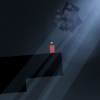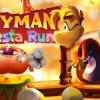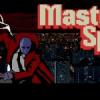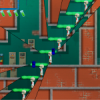What kind of game does your mind conjure up when you think of a title like The Arc? A point-and-click game, perhaps? An RPG? If you said “puzzle platformer”, then take a gold star and feel free to look smug.
Indie developer Jamie Hale - working under the name Pixel Balloon - has taken elements of Metroid, Fez and Super Meat Boy and crafted something that is shaping up to be quite extraordinary. Despite only having been in development for a few short months, there’s already a surprisingly large amount of content, and what we’ve played makes us hungry for the finished product. Hale has a background in the industry, having previously worked for the sadly now-defunct Bizarre Creations on games as diverse as the (excellent) racer Blur and the James Bond game Blood Stone. He’s also previously worked for a number of small mobile gaming studios, before finally making the jump to becoming an Indie developer late last year. The Arc is his first “proper” solo project, and it’s shaping up very well indeed, even at this early stage.
 You play as a guy called Red, who has willingly subjected himself to being absorbed into a giant computer network called The Arc in order to save his friend, Spectrum. The mysterious entities in control of the Arc have promised to free Spectrum, but only if you can prove your worthiness first. Small portions of text, written in first-person, relay Red’s thoughts as he progresses across the levels, while computer terminals will see him communicating with the people in charge. The story never gets in the way of the gameplay though - it’s simply used to provide a little context to the proceedings.
You play as a guy called Red, who has willingly subjected himself to being absorbed into a giant computer network called The Arc in order to save his friend, Spectrum. The mysterious entities in control of the Arc have promised to free Spectrum, but only if you can prove your worthiness first. Small portions of text, written in first-person, relay Red’s thoughts as he progresses across the levels, while computer terminals will see him communicating with the people in charge. The story never gets in the way of the gameplay though - it’s simply used to provide a little context to the proceedings.
The process of being absorbed into the network has seen you reconstituted as a glowing ball of light, while levels take the form of increasingly complex circular worlds along a non-linear map. Some levels have multiple exit doors, and some of those doors can’t be reached until you’ve found an upgrade to your move-set which will allow you to overcome certain obstacles, similar to Metroid. Thus, you’ll spend some time going back to previous levels to open up gateways that were previously inaccessible. In the demo we played, we gained the ability perform a downward smash that could break through certain barriers and reach a previously-inaccessible exit door. There are also various enemies littering some of the worlds, which can be dispatched by jumping into them, and sawblades which need to be avoided.
Movement feels a bit floaty to start with, but quickly becomes second nature - the slow descent of your avatar from the peak of your jump makes some of the tasks required of you a bit more forgiving. Controls are simple, with movement being mapped to the analogue stick and a separate button for jumping (in a previous build, jumping was performed by flicking upwards on the analogue stick, but Hale tells us that he decided to change the control scheme after witnessing a number of people having difficulty getting used to it when demoing the game to the public).
While this all sounds simple in theory, in practice levels can be surprisingly tricky to overcome, requiring a combination of sharp reflexes and lateral thought. Pits of bubbling lava will kill you instantly, while rotating saws need to be avoided, lest you become a… well, whatever it is that floating blobs of light become when sawed in half - prepare to die an awful once the game is finished and released. Much of the game’s challenge comes from attempting to scale a cliff face while avoiding the saws along the way. While you’re only able to perform a triple jump, jumping into one of the glowing green dots that hang suspended in mid-air will refill your jump meter. They’re pretty small though, requiring some precision control while in mid-air. It’s a fun and addictive challenge.
Die - either by colliding with a saw-blade, being hit by an enemy or falling into lava - and you’ll respawn back at the beginning of the level. Thankfully though, Hale has done away with the concept of lives, instead providing infinite restarts should you find yourself repeatedly dying in a certain area of the level - a mechanic he tells us was inspired by Super Meat Boy. In addition, levels are short enough that it never feels as though you’ve lost a lot of progress. Think of them more as bite-sized chunks of puzzle platforming, rather than the lengthy courses of games like Super Mario.
For a game that’s only been development for a few short months, The Arc already looks surprisingly polished. Some attractive painterly visuals from artist Jen Pattison has provided the game with a dream-like, almost Zen ambiance. Looking at it from afar, you’d be forgiven for thinking that it’s a relaxing, casual game to spend a bit of time with after a long day at the office, but the high difficulty level will soon have you realizing that the game provides a stiff challenge. This deception also carries through to the game’s minimalist electronic soundtrack, composed by Jake Worrell. While so far there’s only one composition in the game, and one visual theme, Hale promises that the final game will provide much more variety.
The Arc is shaping up to be something very interesting indeed. It’s also a game that would feel right at home on console platforms such as Sony’s PlayStation Vita, or home consoles. While the game is currently only confirmed for release on PC - tentatively dated for “early 2015″ - Hale is certainly considering other platforms, so there’s a chance of a console release further down the line. And we hope it does - based on our time with it so far, we’re going to go out on a limb and say that The Arc could well end up being a surprise hit.







